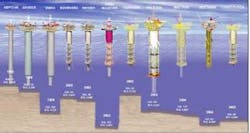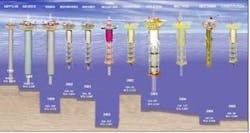Spar history reflects innovation, success
Track record spans three generations
"Archimedes was right." That was the comment made by Ed Horton, then president of Deep Offshore Technology and the man who developed the modern spar design, at the moment of successfully upending the Oryx (now Kerr-McGee) Neptune spar in September 1996, which marked the installation of the world's first production spar platform.
Since then, spars have become established as effective platforms for riser support, processing, and drilling, demonstrating exceptional performance and reliability. Today, the track record of spar installations spans three generations of spar technology (classic, truss, and cell spars) and includes both dry- and wet-tree applications, with and without platform rigs.
Although Neptune represented the first adaptation of a spar for drilling and production duties, the spar itself was not a new concept for use offshore. The Brent spar marked the first oilfield application, having been installed in the North Sea in 1972, where it was used as a successful storage and offloading terminal for over 20 years. The stability of the spar design had previously been employed by oceanographers in the development of the Scripp's FLIP ship, christened in 1962. Nor was Ed Horton new to invention of floater concepts, having invented the TLP in the 1960s. It was Ed's familiarity with both the FLIP ship and the Brent spar, coupled with the knowledge and experience gained from his TLP concept development that formed the basis for the development of the spar production platform.
Technip has provided a variety of engineering, procurement, fabrication, and installation services under many types of contract terms for spar projects. All three classic spars (Kerr- McGee Neptune, ChevronTexaco Genesis, and ExxonMobil Diana) were fabricated at Tech-nip's yard in Pori, Finland, dry-transported in two sections to the Gulf of Mexico, and wet-mated prior to the wet tow to the installation site. In all of the classic spars, production top-tensioned risers are supported by buoyancy cans.
Technip also fabricated all of their truss spars at their yard in Pori, Finland, dry-transported each as a single unit to the GoM, and offloaded the spar prior to the wet tow to the installation site. The exception to this delivery model is the Holstein truss spar, for which the hard tank was fabricated in Finland, and the truss and soft tank were fabricated at Technip's Gulf Marine Fabricators (GMF) yard in Ingleside, Texas. The Holstein hard tank was dry-transported from Finland to GMF, offloaded, then wet-mated to the truss section. This approach was driven by the size of the Holstein spar, which exceeded the capability of the dry-transport vessels to transport it as a single unit. Buoyancy cans supported the production risers for most of the truss spars. However, the Holstein spar differs again, as it employs a production riser tensioner system that is more efficient for the large number of risers.
The first cell spar, Kerr-McGee's Red Hawk, was undertaken as a full EPCI delivery contract and the hull and topsides were fabricated entirely at GMF. Launching of the hull was a two-phase event that involved skidding the hull onto a barge, which was then towed to the heavy lifting device at nearby Kiewit Offshore, where it was lifted from the barge and lowered into the water. Following this offloading operation, it was wet-towed to site and upended in the same way as the classic and truss spars. Red Hawk is also noteworthy as being the first all wet-tree spar.

